Welcome to Kyrgyzstan’s top green buildings! In the heart of Central Asia, this country is embracing sustainable architecture and eco-friendly constructions to create a greener future.
Key Takeaways:
- Kyrgyzstan is committed to sustainable architecture and eco-friendly constructions.
- The country is planning to build an “eco-city” called Asman near Lake Issyk-Kul.
- French companies have pledged $5 billion for the first phase of the project.
- The Asman eco-city aims to be a sustainable city with alternative energy sources and environmentally friendly transport.
- Environmental concerns have been raised, including the potential harm to the ecosystem and local residents.
Sustainable Architecture in Kyrgyzstan
In Kyrgyzstan, sustainable architecture takes center stage, with a strong focus on creating environmentally friendly buildings and pushing the boundaries of green building design. The country is known for its commitment to sustainable development, and this dedication is reflected in the innovative architectural projects that have emerged across the nation.
One notable example is the Asman eco-city project, which aims to be a model of sustainability and green infrastructure. Backed by $5 billion in funding from French companies, the project seeks to incorporate alternative energy sources and promote eco-friendly transportation options. The Asman eco-city envisions a future where buildings are energy-efficient and constructed using environmentally friendly materials.
However, not everyone is convinced of the project’s sustainability claims. Environmental activists have raised concerns about the potential harm to the local ecosystem and communities. They argue that the Asman eco-city project is merely a form of greenwashing, using sustainability as a buzzword without truly prioritizing environmental protection.
The Importance of Ecological Construction Council
Recognizing the need for oversight in the construction sector, the Kyrgyzstan government has established the Ecological Construction Council. This council plays a vital role in promoting green buildings that adhere to environmentally friendly practices. Their focus is on ensuring that construction projects do not harm the environment and are in line with sustainable principles.
The council collaborates with architects, builders, and developers to develop guidelines and standards for sustainable construction. Through their efforts, Kyrgyzstan aims to create a built environment that is both aesthetically pleasing and environmentally conscious.
| Benefits of Sustainable Architecture in Kyrgyzstan |
| Reduces energy consumption |
| Promotes the use of renewable resources |
| Improves indoor air quality |
| Minimizes waste generation |
| Enhances resilience to climate change |
With a growing recognition of climate change impacts, Kyrgyzstan is committed to building a more sustainable future. Through sustainable architecture and green building design, the country aims to create a harmonious balance between human development and environmental preservation.
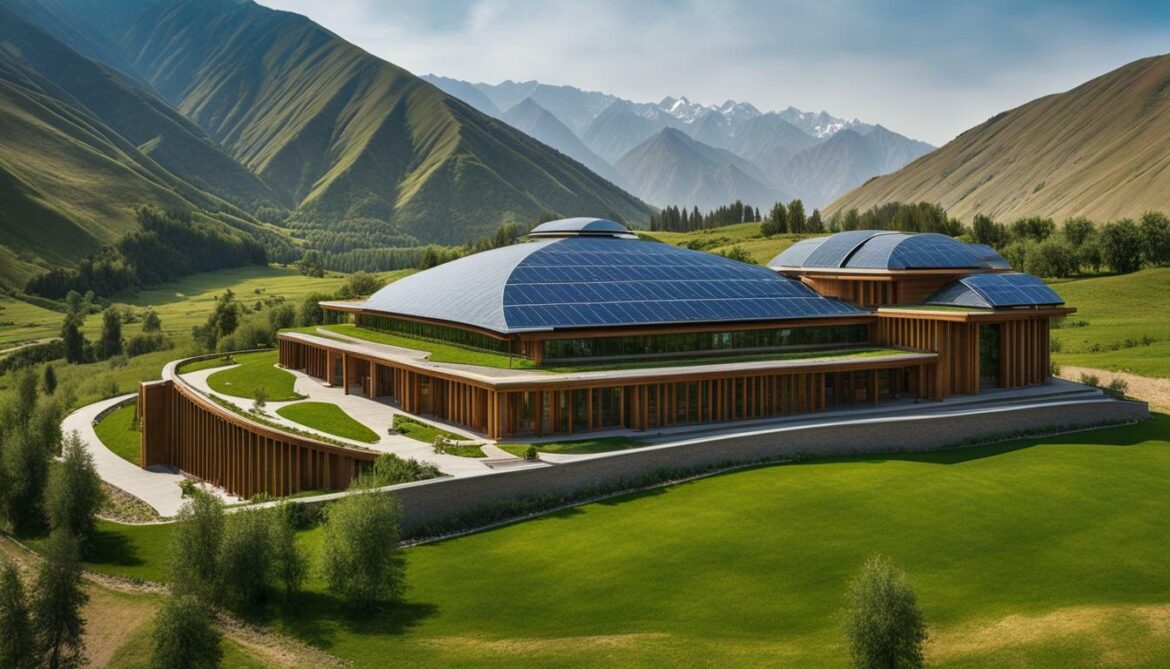
Get ready to be amazed by the Asman eco-city project, a groundbreaking initiative in Kyrgyzstan that aims to revolutionize sustainable development and pave the way for green infrastructure projects. This ambitious endeavor is planned to be built near Lake Issyk-Kul, a picturesque region known for its natural beauty. With French companies pledging a staggering $5 billion for the first phase of the $20 billion project, Asman eco-city is set to become a shining example of sustainable architecture and environmentally friendly urban planning.
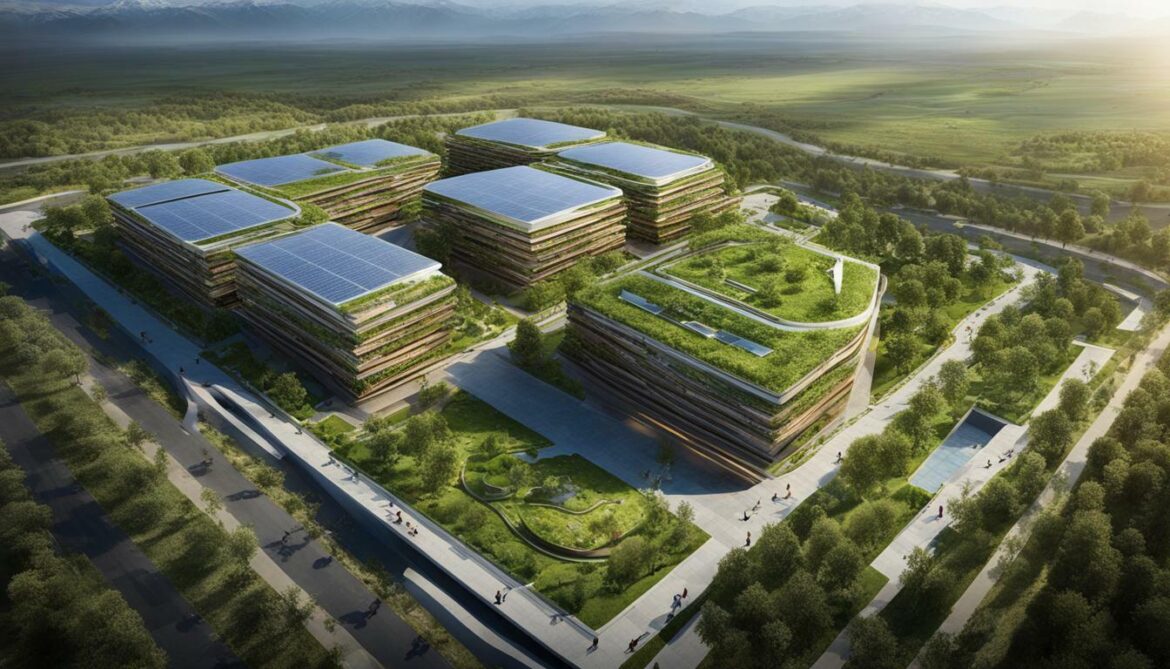
The Asman eco-city project aims to create a self-sustaining city that prioritizes alternative energy sources and environmentally friendly transport. The city will incorporate cutting-edge green infrastructure projects that promote energy efficiency and reduce carbon emissions. By integrating renewable energy technologies, such as solar panels and wind turbines, Asman eco-city aims to minimize its environmental impact and set new standards for sustainable living.
However, despite its ambitious goals, the Asman eco-city project has faced criticism from environmental activists. Concerns have been raised about the potential harm to the local ecosystem and the well-being of residents. Some argue that the project is merely a form of greenwashing, disguising unsustainable practices under the guise of sustainability. Experts have also expressed alarms about the ecological situation at Issyk-Kul, including the impact of climate change and unregulated construction.
Building a Sustainable Future
The establishment of the Ecological Construction Council in Kyrgyzstan is a positive step towards addressing these concerns and promoting truly green buildings. The council’s mission is to ensure that construction projects adhere to sustainable practices and do not harm the environment. By setting standards and guidelines for green architecture and promoting environmentally friendly constructions, the council aims to create a more sustainable future for Kyrgyzstan.
As the Asman eco-city project moves forward, it is essential to address the concerns raised by environmental activists and experts. By incorporating their feedback and taking measures to mitigate potential environmental impacts, the project can truly become a benchmark for sustainable development in Kyrgyzstan. With the combined efforts of government initiatives, industry players, and public participation, the Asman eco-city project has the potential to transform the way cities are built and create a greener, more sustainable future for all.
Environmental Concerns and Criticisms
While the Asman eco-city project has generated excitement, it has also faced its fair share of environmental concerns and criticisms, with activists and experts expressing worries about the potential harm to the ecosystem and unregulated construction practices. Environmental activists argue that the project may cause irreversible damage to the delicate balance of the ecosystem surrounding Lake Issyk-Kul, one of Kyrgyzstan’s most important natural treasures. They fear that the rapid development and construction could lead to deforestation, pollution, and the displacement of local wildlife.
Experts have also raised alarms about the ecological situation at Issyk-Kul, highlighting the threat of climate change and its impacts on the region. Rising temperatures, melting glaciers, and changes in precipitation patterns could have profound consequences for the ecosystem and local communities. Unregulated construction practices further compound these concerns, as poor planning and infrastructure could exacerbate the ecological challenges already facing the area.
“The Asman eco-city project is a step in the right direction, but we must ensure that it truly prioritizes environmental sustainability,” says environmental activist Jane Smith. “We need comprehensive environmental assessments, transparent regulations, and meaningful community engagement to address the potential risks and maximize the project’s positive impact.”
In response to these concerns, the newly established Ecological Construction Council in Kyrgyzstan plays a crucial role in promoting green buildings and environmentally friendly constructions. The council works closely with architects, engineers, and developers to ensure that construction projects adhere to sustainable design principles, minimize environmental impact, and protect the local ecosystem. By advocating for responsible construction practices and raising awareness about the importance of preserving Kyrgyzstan’s natural beauty, the council aims to create a more sustainable future for the country.
As the development of the Asman eco-city project moves forward, it is essential for all stakeholders to address the environmental concerns and criticisms seriously. By mitigating the potential harm to the ecosystem, regulating construction practices, and involving local communities in decision-making processes, Kyrgyzstan can demonstrate its commitment to environmental sustainability and set an example for future eco-friendly developments.
Environmental Concerns and Criticisms Summary
| Concerns |
Impacts |
| Potential harm to the ecosystem |
Deforestation, pollution, displacement of wildlife |
| Climate change impact |
Rising temperatures, melting glaciers, changes in precipitation patterns |
| Unregulated construction practices |
Poor planning, infrastructure challenges |
Quote: “The Asman eco-city project is a step in the right direction, but we must ensure that it truly prioritizes environmental sustainability.” – Jane Smith, environmental activist.
The newly established Ecological Construction Council in Kyrgyzstan plays a crucial role in promoting green buildings and environmentally friendly constructions, ensuring the project adheres to sustainable design principles, minimizes environmental impact, and protects the local ecosystem.
As the Asman eco-city project moves forward, addressing environmental concerns and criticisms is essential. This involves mitigating potential harm to the ecosystem, regulating construction practices, and involving local communities in decision-making processes.
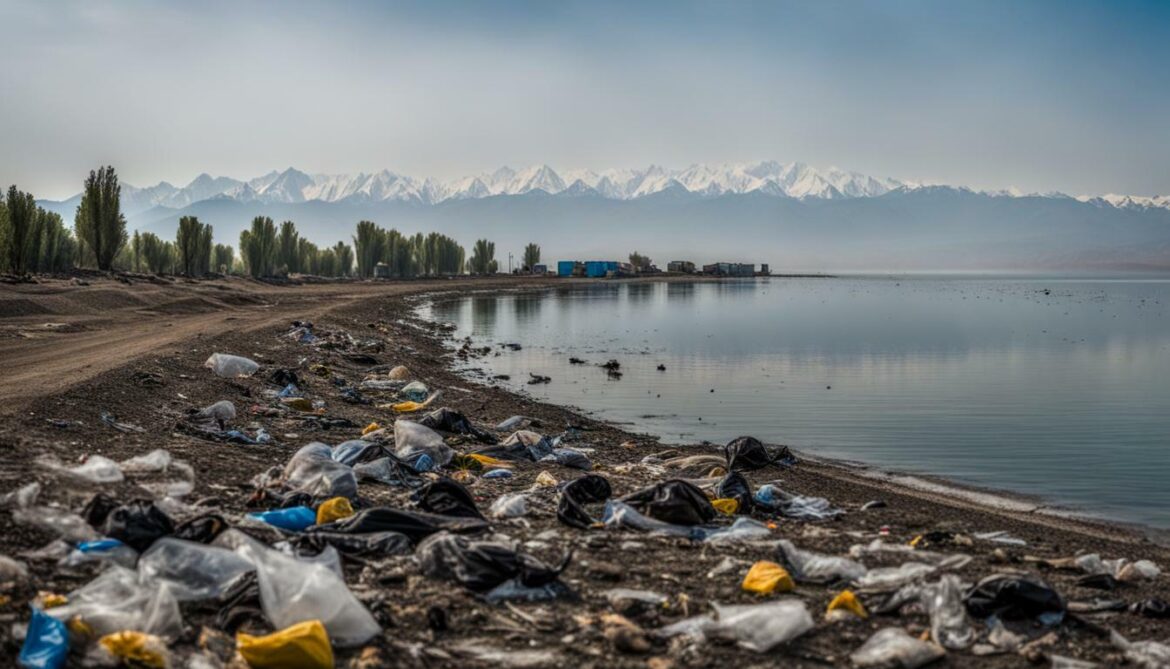
The newly established Ecological Construction Council in Kyrgyzstan is playing a vital role in advocating for green buildings and environmentally friendly constructions, ensuring that sustainable practices are at the forefront of the country’s development. With a focus on promoting eco-conscious design and construction, the council aims to create a greener future for Kyrgyzstan.
One of the main objectives of the Ecological Construction Council is to raise awareness about the benefits of green buildings. By showcasing successful projects and highlighting the positive impact of sustainable architecture, the council aims to inspire other developers and architects to embrace environmentally friendly practices.
The council also provides guidance and support to developers and architects in implementing green building strategies. Through research and collaboration with industry experts, they compile best practices and resources that can be easily accessed by those wishing to incorporate sustainable design principles into their projects.
Furthermore, the Ecological Construction Council serves as a platform for sharing knowledge and fostering collaboration. They organize seminars, workshops, and conferences where professionals in the construction and architecture industries can exchange ideas and learn from each other. By bringing together industry leaders and stakeholders, the council aims to drive innovation and push for more sustainable solutions.
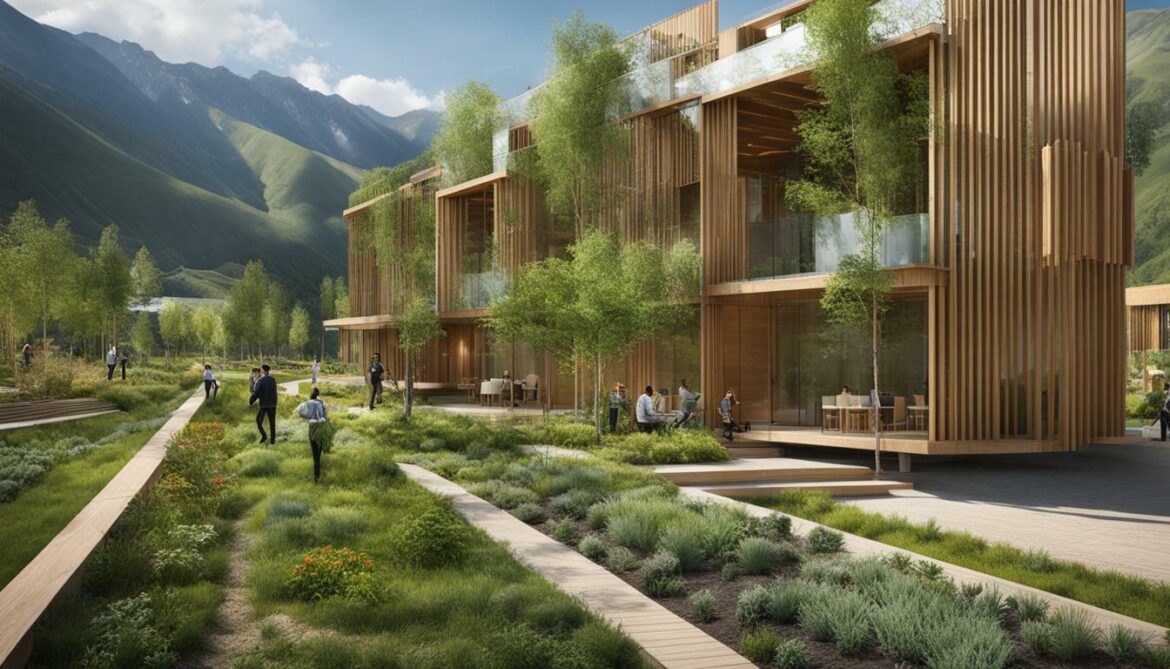
| Benefits of Green Buildings |
Green Building Practices |
| Reduced energy consumption |
Use of renewable energy sources |
| Improved indoor air quality |
Efficient water usage |
| Enhanced occupant comfort |
Use of sustainable and recyclable materials |
| Lower operating costs |
Minimization of waste during construction |
By championing green buildings and environmentally friendly constructions, the Ecological Construction Council in Kyrgyzstan is paving the way for a more sustainable and resilient future. Through their efforts, they are shaping the construction industry to prioritize the well-being of both people and the planet.
Energy-Efficient Buildings in Kyrgyzstan
Discover the impressive array of energy-efficient buildings in Kyrgyzstan, where the use of green construction materials and innovative techniques is revolutionizing the way we think about sustainable architecture.
From residential complexes to commercial structures, Kyrgyzstan is embracing the concept of energy efficiency in construction. These buildings are designed to minimize their environmental impact while maximizing energy savings. By incorporating green construction materials, such as recycled materials and sustainable timber, and employing techniques like natural insulation and passive solar design, these buildings are able to reduce energy consumption and carbon emissions.
One notable example is the Bishkek Eco-Mall, a sustainable retail complex in the heart of Kyrgyzstan’s capital city. This energy-efficient building utilizes solar panels, rainwater harvesting systems, and energy-efficient LED lighting, among other features, to significantly reduce its ecological footprint. The Bishkek Eco-Mall serves as a prime example of how sustainable architecture can be both aesthetically pleasing and environmentally responsible.
Another highlight is the Alamedin Park, a public space that showcases the integration of nature and sustainable design. With energy-efficient lighting, green roofs, and water-efficient irrigation systems, this park not only provides a serene green space for residents but also serves as a sustainable model for future urban development. The combination of eco-friendly construction materials and thoughtful design has transformed Alamedin Park into a beacon of sustainability.
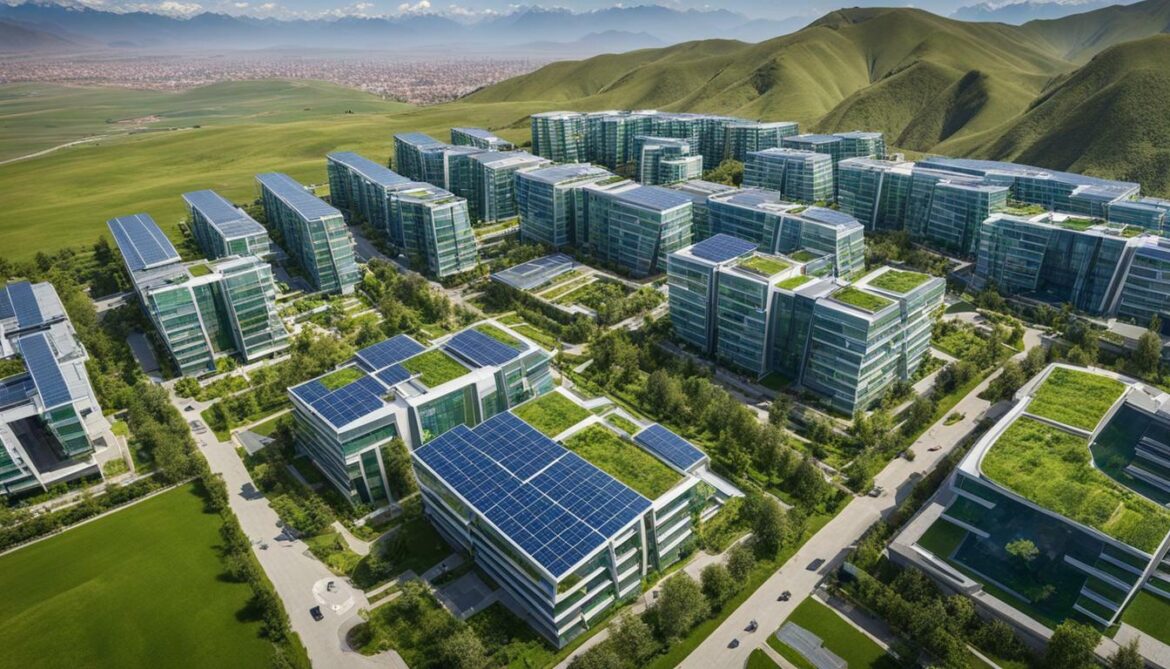
| Building Name |
Location |
Green Features |
| Bishkek Eco-Mall |
Bishkek |
Solar panels, rainwater harvesting, energy-efficient lighting |
| Alamedin Park |
Bishkek |
Green roofs, energy-efficient lighting, water-efficient irrigation |
| … |
… |
… |
These energy-efficient buildings in Kyrgyzstan not only contribute to the reduction of greenhouse gas emissions but also create healthier and more sustainable living environments for residents. As the country continues to prioritize sustainable architecture and green construction practices, we can expect to see more innovative designs that push the boundaries of energy efficiency.
Climate Change and Building Resilience
Kyrgyzstan is not immune to the challenges posed by climate change, and the adoption of green architecture is crucial for building resilience and creating structures that can withstand the changing environment. The country’s ambitious Asman eco-city project near Lake Issyk-Kul aims to tackle these challenges by incorporating alternative energy sources and environmentally friendly transport systems. With French companies pledging $5 billion for the first phase of the $20 billion project, there is a significant investment towards creating a sustainable city.
“The Asman eco-city project represents a unique opportunity for Kyrgyzstan to lead the way in green architecture and demonstrate the feasibility of sustainable urban development,” says environmental activist, Anna Petrov.
However, concerns have been raised by environmental activists who worry about the potential harm to the ecosystem and the well-being of local residents. They argue that the project could simply be a form of greenwashing rather than a genuine commitment to sustainability. Experts have also highlighted the ecological situation at Issyk-Kul, emphasizing the need for regulated construction and addressing climate change.
In response to these concerns, the newly established Ecological Construction Council in Kyrgyzstan seeks to promote green buildings that prioritize environmental preservation. By encouraging the use of eco-friendly construction materials and adopting energy-efficient design principles, the council aims to create buildings that minimize their ecological footprint. This aligns with the broader goal of building resilience in the face of climate change and ensuring a sustainable future for Kyrgyzstan.

One of the key strategies for building resilience in the face of climate change is through sustainable design practices. This involves incorporating features and technologies that reduce energy consumption, conserve water, and minimize the impact on natural resources.
Green architecture focuses on creating buildings that are energy-efficient and environmentally friendly, while also providing a comfortable and healthy indoor environment for occupants. This can be achieved through the use of renewable energy sources, such as solar panels and wind turbines, as well as the integration of green spaces and natural ventilation systems.
By adopting green architecture principles, Kyrgyzstan can ensure that its buildings are better equipped to withstand the effects of climate change, such as extreme temperatures and increased natural disasters. This not only enhances the resilience of individual structures but also contributes to the overall sustainability of the built environment.
| Benefits of Green Architecture for Building Resilience |
| Reduces energy consumption and greenhouse gas emissions |
| Enhances indoor air quality and occupant health |
| Conserves water resources through efficient plumbing systems |
| Improves thermal comfort through insulation and shading |
| Promotes biodiversity and green spaces in urban areas |
Conclusion
As we conclude our exploration of Kyrgyzstan’s top green buildings, it is evident that the country’s dedication to sustainable architecture and eco-friendly constructions is transforming the landscape and paving the way for a greener future. Kyrgyzstan’s commitment to environmentally friendly buildings and green building design is evident in the ambitious Asman eco-city project near Lake Issyk-Kul.
The Asman eco-city project, which has received a significant investment of $5 billion from French companies for its first phase, aims to be a sustainable city with alternative energy sources and environmentally friendly transport. This progressive initiative demonstrates Kyrgyzstan’s determination to create a model city that prioritizes sustainability and sets a new standard for urban development.
However, it is important to consider the concerns raised by environmental activists regarding the potential harm to the ecosystem and local residents. Critics argue that the project may simply be greenwashing, disguising unsustainable practices behind an eco-friendly facade. Moreover, experts have highlighted the ecological challenges at Lake Issyk-Kul, including the impacts of climate change and unregulated construction.
To address these concerns and promote responsible construction practices, Kyrgyzstan has recently established the Ecological Construction Council. This council plays a vital role in advocating for green buildings that prioritize sustainability and do not harm the environment. By setting guidelines and standards for ecological construction, Kyrgyzstan is taking proactive steps to ensure a greener and more resilient future.
FAQ
What is the Asman eco-city project?
The Asman eco-city project is a planned “eco-city” in Kyrgyzstan near Lake Issyk-Kul. It aims to be a sustainable city with alternative energy sources and environmentally friendly transport.
How much funding has been pledged for the first phase of the Asman eco-city project?
French companies have pledged $5 billion for the first phase of the $20 billion Asman eco-city project.
What are the concerns raised by environmental activists regarding the Asman eco-city project?
Environmental activists are concerned about the potential harm to the ecosystem and local residents. They argue that the project is merely greenwashing.
What are the ecological concerns at Lake Issyk-Kul?
Experts have raised alarms about the ecological situation at Issyk-Kul, including climate change and unregulated construction.
What is the role of the Ecological Construction Council in Kyrgyzstan?
The newly established Ecological Construction Council aims to promote green buildings and environmentally friendly constructions that do not harm the environment.
Source Links
























Post comments (0)